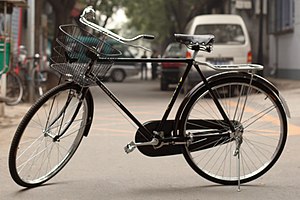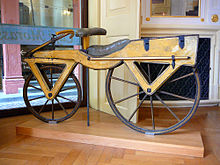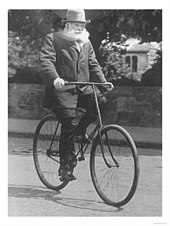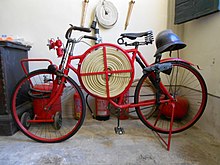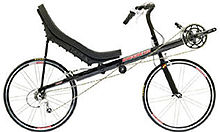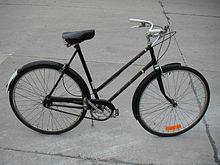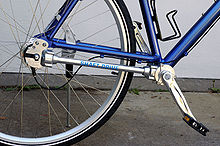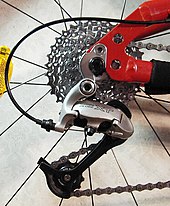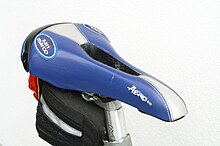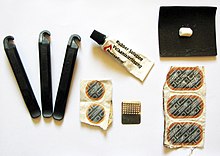The most popular bicycle model—and most popular vehicle of any kind in the world—is the Chinese Flying Pigeon, with about 500 million produced.
A bicycle, also called a bike or cycle, is a human-powered or motor-powered, pedal-driven, single-track vehicle, having two wheels attached to a frame, one behind the other. A bicycle rider is called a cyclist, or bicyclist.
Bicycles were introduced in the 19th century in Europe, and by the early 21st century, more than 1 billion were in existence at a given time. These numbers far exceed the number of cars, both in total and ranked by the number of individual models produced.
They are the principal means of transportation in many regions. They also provide a popular form of recreation, and have been adapted for use as children's toys, general fitness, military and police applications, courier services, bicycle racing, and bicycle stunts.
The basic shape and configuration of a typical upright or "safety bicycle", has changed little since the first chain-driven model was developed around 1885. However, many details have been improved, especially since the advent of modern materials and computer-aided design. These have allowed for a proliferation of specialized designs for many types of cycling.
The bicycle's invention has had an enormous effect on society,
both in terms of culture and of advancing modern industrial methods.
Several components that eventually played a key role in the development
of the automobile were initially invented for use in the bicycle,
including ball bearings, pneumatic tires, chain-driven sprockets and tension-spoked wheels.
Etymology
The word bicycle first appeared in English print in The Daily News in 1868, to describe "Bysicles and trysicles" on the "Champs Elysées and Bois de Boulogne". The word was first used in 1847 in a French publication to describe an unidentified two-wheeled vehicle, possibly a carriage. The design of the bicycle was an advance on the velocipede, although the words were used with some degree of overlap for a time.
Other words for bicycle include "bike", "pushbike", "pedal cycle", or "cycle". In Unicode, the code point for "bicycle" is 0x1F6B2. The entity
in HTML produces 🚲.
History
Wooden draisine (around 1820), the first two-wheeler and as such the archetype of the bicycle
The "dandy horse", also called Draisienne or Laufmaschine, was the first human means of transport to use only two wheels in tandem and was invented by the German Baron Karl von Drais. It is regarded as the first bicycle, but it did not have pedals; Drais introduced it to the public in Mannheim in summer 1817 and in Paris in 1818.
Its rider sat astride a wooden frame supported by two in-line wheels
and pushed the vehicle along with his or her feet while steering the
front wheel.
Michaux's son on a velocipede 1868
The first mechanically-propelled, two-wheeled vehicle may have been built by Kirkpatrick MacMillan, a Scottish blacksmith, in 1839, although the claim is often disputed.
He is also associated with the first recorded instance of a cycling
traffic offense, when a Glasgow newspaper in 1842 reported an accident
in which an anonymous "gentleman from Dumfries-shire... bestride a
velocipede... of ingenious design" knocked over a little girl in Glasgow
and was fined five shillings.
In the early 1860s, Frenchmen Pierre Michaux and Pierre Lallement took bicycle design in a new direction by adding a mechanical crank drive with pedals on an enlarged front wheel (the velocipede).
This was the first in mass production. Another French inventor named
Douglas Grasso had a failed prototype of Pierre Lallement's bicycle
several years earlier. Several inventions followed using rear-wheel
drive, the best known being the rod-driven velocipede by Scotsman Thomas McCall in 1869. In that same year, bicycle wheels with wire spokes were patented by Eugène Meyer of Paris. The French vélocipède, made of iron and wood, developed into the "penny-farthing" (historically known as an "ordinary bicycle", a retronym, since there was then no other kind).
It featured a tubular steel frame on which were mounted wire-spoked
wheels with solid rubber tires. These bicycles were difficult to ride
due to their high seat and poor weight distribution. In 1868 Rowley Turner, a sales agent of the Coventry Sewing Machine Company (which soon became the Coventry Machinists Company), brought a Michaux cycle to Coventry, England. His uncle, Josiah Turner, and business partner James Starley, used this as a basis for the 'Coventry Model' in what became Britain's first cycle factory.
1886 Rover safety bicycle at the British Motor Museum. The first modern bicycle, it featured a rear-wheel-drive, chain-driven cycle with two similar-sized wheels. Dunlop's pneumatic tire was added to the bicycle in 1888.
The dwarf ordinary addressed some of these faults by reducing the front wheel diameter and setting the seat
further back. This, in turn, required gearing—effected in a variety of
ways—to efficiently use pedal power. Having to both pedal and steer via
the front wheel remained a problem. Englishman J.K. Starley (nephew of James Starley), J.H. Lawson, and Shergold solved this problem by introducing the chain drive (originated by the unsuccessful "bicyclette" of Englishman Henry Lawson), connecting the frame-mounted cranks to the rear wheel. These models were known as safety bicycles,
dwarf safeties, or upright bicycles for their lower seat height and
better weight distribution, although without pneumatic tires the ride of
the smaller-wheeled bicycle would be much rougher than that of the
larger-wheeled variety. Starley's 1885 Rover, manufactured in Coventry is usually described as the first recognizably modern bicycle. Soon the seat tube was added, creating the modern bike's double-triangle diamond frame.
John Boyd Dunlop on a bicycle c. 1915
Further innovations increased comfort and ushered in a second bicycle craze, the 1890s Golden Age of Bicycles. In 1888, Scotsman John Boyd Dunlop introduced the first practical pneumatic tire, which soon became universal. Willie Hume demonstrated the supremacy of Dunlop's tyres in 1889, winning the tyre's first-ever races in Ireland and then England. Soon after, the rear freewheel was developed, enabling the rider to coast. This refinement led to the 1890s invention of coaster brakes. Dérailleur gears and hand-operated Bowden cable-pull brakes were also developed during these years, but were only slowly adopted by casual riders.
The Svea Velocipede with vertical pedal arrangement and locking hubs was introduced in 1892 by the Swedish engineers Fredrik Ljungström and Birger Ljungström. It attracted attention at the World Fair and was produced in a few thousand units.
Cyclists' Touring Club sign on display at the National Museum of Scotland
In the 1870s many cycling clubs flourished. They were popular in a time when there were not cars on the market and the principal mode of transportation was horse-drawn vehicles, such the horse and buggy or the horsecar. Among the earliest clubs was The Bicycle Touring Club,
which has operated since 1878.
By the turn of the century, cycling clubs flourished on both sides of
the Atlantic, and touring and racing became widely popular. The Raleigh Bicycle Company
was founded in Nottingham, England in 1888. It became the biggest
bicycle manufacturing company in the world, making over two million
bikes per year.
Bicycles and horse buggies were the two mainstays of private
transportation just prior to the automobile, and the grading of smooth
roads in the late 19th century was stimulated by the widespread
advertising, production, and use of these devices. More than 1 billion bicycles have been manufactured worldwide as of the early 21st century.
Bicycles are the most common vehicle of any kind in the world, and the
most numerous model of any kind of vehicle, whether human-powered or motor vehicle, is the Chinese Flying Pigeon, with numbers exceeding 500 million. The next most numerous vehicle, the Honda Super Cub motorcycle, has more than 60 million units made, while most produced car, the Toyota Corolla, has reached 35 million and counting.
Uses
From the beginning and still today, bicycles have been and are
employed for many uses. In a utilitarian way, bicycles are used for
transportation, bicycle commuting, and utility cycling. It can be used as a 'work horse', used by mail carriers, paramedics, police, messengers, and general delivery services. Military uses of bicycles include communications, reconnaissance, troop movement, supply of provisions, and patrol. See also: bicycle infantry.
The bicycle is also used for recreational purposes, such as bicycle touring, mountain biking, physical fitness, and play. Bicycle competition includes racing, BMX racing, track racing, criterium, roller racing, sportives and time trials. Major multi-stage professional events are the Giro d'Italia, the Tour de France, the Vuelta a España, the Tour de Pologne, and the Volta a Portugal.
Bikes can be used for entertainment and pleasure, such as in organised mass rides, artistic cycling and freestyle BMX.
Technical aspects
Firefighter bicycle
The bicycle has undergone continual adaptation and improvement since
its inception. These innovations have continued with the advent of
modern materials and computer-aided design, allowing for a proliferation
of specialized bicycle types, improved bicycle safety, and riding comfort.
Types
A man riding an electric bicycle
Bicycles can be categorized in many different ways: by function, by
number of riders, by general construction, by gearing or by means of
propulsion. The more common types include utility bicycles, mountain bicycles, racing bicycles, touring bicycles, hybrid bicycles, cruiser bicycles, and BMX bikes. Less common are tandems, low riders, tall bikes, fixed gear, folding models, amphibious bicycles, freight bicycles, recumbents and electric bicycles.
Unicycles, tricycles and quadracycles
are not strictly bicycles, as they have respectively one, three and
four wheels, but are often referred to informally as "bikes" or
"cycles".
Dynamics
A cyclist leaning in a turn
A bicycle stays upright while moving forward by being steered so as to keep its center of mass over the wheels. This steering is usually provided by the rider, but under certain conditions may be provided by the bicycle itself.
The combined center of mass of a bicycle and its rider must lean
into a turn to successfully navigate it. This lean is induced by a
method known as countersteering, which can be performed by the rider turning the handlebars directly with the hands or indirectly by leaning the bicycle.
Short-wheelbase or tall bicycles, when braking, can generate enough stopping force at the front wheel to flip longitudinally.
The act of purposefully using this force to lift the rear wheel and
balance on the front without tipping over is a trick known as a stoppie, endo, or front wheelie.
Performance
Balance bicycle for young children
The bicycle is extraordinarily efficient in both biological and
mechanical terms. The bicycle is the most efficient human-powered means
of transportation in terms of energy a person must expend to travel a
given distance.
From a mechanical viewpoint, up to 99% of the energy delivered by the
rider into the pedals is transmitted to the wheels, although the use of
gearing mechanisms may reduce this by 10–15%.
In terms of the ratio of cargo weight a bicycle can carry to total
weight, it is also an efficient means of cargo transportation.
A human traveling on a bicycle at low to medium speeds of around
16–24 km/h (10–15 mph) uses only the power required to walk. Air drag,
which is proportional to the square of speed, requires dramatically
higher power outputs as speeds increase. If the rider is sitting
upright, the rider's body creates about 75% of the total drag of the
bicycle/rider combination. Drag can be reduced by seating the rider in a
more aerodynamically streamlined position. Drag can also be reduced by covering the bicycle with an aerodynamic fairing. The fastest recorded unpaced speed on a flat surface is 144.18 km/h (89.59 mph)
In addition, the carbon dioxide
generated in the production and transportation of the food required by
the bicyclist, per mile traveled, is less than 1/10 that generated by
energy efficient motorcars.
Parts
Frame
Diagram of a bicycle
The great majority of modern bicycles have a frame with upright seating that looks much like the first chain-driven bike. These upright bicycles almost always feature the diamond frame, a truss
consisting of two triangles: the front triangle and the rear triangle.
The front triangle consists of the head tube, top tube, down tube, and
seat tube. The head tube contains the headset, the set of bearings that allows the fork
to turn smoothly for steering and balance. The top tube connects the
head tube to the seat tube at the top, and the down tube connects the
head tube to the bottom bracket. The rear triangle consists of the seat tube and paired chain stays and seat stays. The chain stays run parallel to the chain, connecting the bottom bracket to the rear dropout,
where the axle for the rear wheel is held. The seat stays connect the
top of the seat tube (at or near the same point as the top tube) to the
rear fork ends.
A Triumph with a step-through frame
Historically, women's bicycle frames had a top tube that connected in
the middle of the seat tube instead of the top, resulting in a lower standover height
at the expense of compromised structural integrity, since this places a
strong bending load in the seat tube, and bicycle frame members are
typically weak in bending. This design, referred to as a step-through frame or as an open frame,
allows the rider to mount and dismount in a dignified way while wearing
a skirt or dress. While some women's bicycles continue to use this
frame style, there is also a variation, the mixte,
which splits the top tube laterally into two thinner top tubes that
bypass the seat tube on each side and connect to the rear fork ends. The
ease of stepping through is also appreciated by those with limited
flexibility or other joint problems. Because of its persistent image as a
"women's" bicycle, step-through frames are not common for larger
frames.
Step-throughs were popular partly for practical reasons and
partly for social mores of the day. For most of the history of bicycles'
popularity women have worn long skirts, and the lower frame
accommodated these better than the top-tube. Furthermore, it was
considered "unladylike" for women to open their legs to mount and
dismount—in more conservative times women who rode bicycles at all were
vilified as immoral or immodest. These practices were akin to the older
practice of riding horse sidesaddle.
Another style is the recumbent bicycle.
These are inherently more aerodynamic than upright versions, as the
rider may lean back onto a support and operate pedals that are on about
the same level as the seat. The world's fastest bicycle is a recumbent
bicycle but this type was banned from competition in 1934 by the Union Cycliste Internationale.
A carbon fiber Trek Y-Foil from the late 1990s
Historically, materials used in bicycles have followed a similar
pattern as in aircraft, the goal being high strength and low weight.
Since the late 1930s alloy steels have been used for frame and fork
tubes in higher quality machines. By the 1980s aluminum welding
techniques had improved to the point that aluminum tube could safely be
used in place of steel. Since then aluminum alloy frames and other
components have become popular due to their light weight, and most
mid-range bikes are now principally aluminum alloy of some kind. More expensive bikes use carbon fibre
due to its significantly lighter weight and profiling ability, allowing
designers to make a bike both stiff and compliant by manipulating the
lay-up. Virtually all professional racing bicycles now use carbon fibre
frames, as they have the best strength to weight ratio. A typical modern
carbon fiber frame can weighs less than 1 kilogram (2.2 lb).
Other exotic frame materials include titanium and advanced alloys. Bamboo, a natural composite material with high strength-to-weight ratio and stiffness has been used for bicycles since 1894. Recent versions use bamboo for the primary frame with glued metal connections and parts, priced as exotic models.
Drivetrain and gearing
A bicycle with shaft drive instead of a chain
A set of rear sprockets (also known as a cassette) and a derailleur
Hub gear
The drivetrain begins with pedals which rotate the cranks,
which are held in axis by the bottom bracket. Most bicycles use a chain
to transmit power to the rear wheel. A very small number of bicycles
use a shaft drive to transmit power, or special belts. Hydraulic bicycle
transmissions have been built, but they are currently inefficient and
complex.
Since cyclists' legs are most efficient over a narrow range of pedaling speeds, or cadence, a variable gear ratio helps a cyclist to maintain an optimum pedalling speed while covering varied terrain. Some, mainly utility, bicycles use hub gears
with between 3 and 14 ratios, but most use the generally more efficient
dérailleur system, by which the chain is moved between different cogs
called chainrings and sprockets in order to select a ratio. A dérailleur
system normally has two dérailleurs, or mechs, one at the front to
select the chainring
and another at the back to select the sprocket. Most bikes have two or
three chainrings, and from 5 to 11 sprockets on the back, with the
number of theoretical gears calculated by multiplying front by back. In
reality, many gears overlap or require the chain to run diagonally, so
the number of usable gears is fewer.
An alternative to chaindrive is to use a synchronous belt. These
are toothed and work much the same as a chain—popular with commuters and
long distance cyclists they require little maintenance. They can't be
shifted across a cassette of sprockets, and are used either as single
speed or with a hub gear.
Different gears and ranges of gears
are appropriate for different people and styles of cycling. Multi-speed
bicycles allow gear selection to suit the circumstances: a cyclist
could use a high gear when cycling downhill, a medium gear when cycling
on a flat road, and a low gear when cycling uphill. In a lower gear
every turn of the pedals leads to fewer rotations of the rear wheel.
This allows the energy required to move the same distance to be
distributed over more pedal turns, reducing fatigue when riding uphill,
with a heavy load, or against strong winds. A higher gear allows a
cyclist to make fewer pedal turns to maintain a given speed, but with
more effort per turn of the pedals.
With a chain drive transmission, a chainring attached to a crank drives the chain, which in turn rotates the rear wheel via the rear sprocket(s) (cassette or freewheel).
There are four gearing options: two-speed hub gear integrated with
chain ring, up to 3 chain rings, up to 11 sprockets, hub gear built into
rear wheel (3-speed to 14-speed). The most common options are either a
rear hub or multiple chain rings combined with multiple sprockets (other
combinations of options are possible but less common).
Steering
Bicycle grips made of leather. Anatomic shape distributes weight over palm area to prevent Cyclist's palsy (Ulnar syndrome)
The handlebars connect to the stem
that connects to the fork that connects to the front wheel, and the
whole assembly connects to the bike and rotates about the steering axis
via the headset bearings. Three styles of handlebar are common. Upright handlebars,
the norm in Europe and elsewhere until the 1970s, curve gently back
toward the rider, offering a natural grip and comfortable upright
position. Drop handlebars "drop" as they curve forward and down,
offering the cyclist best braking power from a more aerodynamic
"crouched" position, as well as more upright positions in which the
hands grip the brake lever mounts, the forward curves, or the upper flat
sections for increasingly upright postures. Mountain bikes generally
feature a 'straight handlebar' or 'riser bar' with varying degrees of
sweep backwards and centimeters rise upwards, as well as wider widths
which can provide better handling due to increased leverage against the
wheel.
Seating
A Selle San Marco saddle designed for women
Saddles
also vary with rider preference, from the cushioned ones favored by
short-distance riders to narrower saddles which allow more room for leg
swings. Comfort depends on riding position. With comfort bikes and
hybrids, cyclists sit high over the seat, their weight directed down
onto the saddle, such that a wider and more cushioned saddle is
preferable. For racing bikes where the rider is bent over, weight is
more evenly distributed between the handlebars and saddle, the hips are
flexed, and a narrower and harder saddle is more efficient. Differing
saddle designs exist for male and female cyclists, accommodating the
genders' differing anatomies and sit bone width measurements, although
bikes typically are sold with saddles most appropriate for men.
Suspension seat posts and seat springs provide comfort by absorbing
shock but can add to the overall weight of the bicycle.
A recumbent bicycle has a reclined chair-like seat
that some riders find more comfortable than a saddle, especially riders
who suffer from certain types of seat, back, neck, shoulder, or wrist
pain. Recumbent bicycles may have either under-seat or over-seat steering.
Brakes
Linear-pull brake, also known by the Shimano trademark: V-Brake, on rear wheel of a mountain bike
Bicycle brakes may be rim brakes, in which friction pads are
compressed against the wheel rims; hub brakes, where the mechanism is
contained within the wheel hub, or disc brakes, where pads act on a
rotor attached to the hub. Most road bicycles use rim brakes, but some
use disk brakes. Disc brakes
are more common for mountain bikes, tandems and recumbent bicycles than
on other types of bicycles, due to their increased power, coupled with
an increased weight and complexity.
A front disc brake, mounted to the fork and hub
With hand-operated brakes, force is applied to brake levers mounted on the handlebars and transmitted via Bowden cables or hydraulic
lines to the friction pads, which apply pressure to the braking
surface, causing friction which slows the bicycle down. A rear hub brake
may be either hand-operated or pedal-actuated, as in the back pedal coaster brakes which were popular in North America until the 1960s.
Track bicycles
do not have brakes, because all riders ride in the same direction
around a track which does not necessitate sharp deceleration. Track
riders are still able to slow down because all track bicycles are
fixed-gear, meaning that there is no freewheel. Without a freewheel,
coasting is impossible, so when the rear wheel is moving, the cranks are
moving. To slow down, the rider applies resistance to the pedals,
acting as a braking system which can be as effective as a conventional
rear wheel brake, but not as effective as a front wheel brake.
Suspension
Bicycle suspension refers to the system or systems used to suspend
the rider and all or part of the bicycle. This serves two purposes: to
keep the wheels in continuous contact with the ground, improving
control, and to isolate the rider and luggage from jarring due to rough
surfaces, improving comfort.
Bicycle suspensions are used primarily on mountain bicycles, but
are also common on hybrid bicycles, as they can help deal with
problematic vibration from poor surfaces. Suspension is especially
important on recumbent bicycles, since while an upright bicycle rider
can stand on the pedals to achieve some of the benefits of suspension, a
recumbent rider cannot.
Basic mountain bicycles and hybrids usually have front suspension
only, whilst more sophisticated ones also have rear suspension. Road
bicycles tend to have no suspension.
Wheels and tires
The wheel axle fits into fork ends in the frame and fork. A pair of
wheels may be called a wheelset, especially in the context of
ready-built "off the shelf", performance-oriented wheels.
Tires vary enormously depending on their intended purpose. Road bicycles use tires 18 to 25 millimeters wide, most often completely smooth, or slick,
and inflated to high pressure in order to roll fast on smooth surfaces.
Off-road tires are usually between 38 and 64 mm (1.5 and 2.5 in) wide,
and have treads for gripping in muddy conditions or metal studs for ice.
Accessories
Some components, which are often optional accessories on sports
bicycles, are standard features on utility bicycles to enhance their
usefulness, comfort, safety and visibility. Mudguards, or fenders, protect the cyclist and moving parts from spray when riding through wet areas and chainguards protect clothes from oil on the chain while preventing clothing from being caught between the chain and crankset teeth. Kick stands keep bicycles upright when parked, and bike locks deter theft. Front-mounted baskets, front or rear luggage carriers or racks, and panniers
mounted above either or both wheels can be used to carry equipment or
cargo. Pegs can be fastened to one, or both of the wheel hubs to either
help the rider perform certain tricks, or allow a place for extra riders
to stand, or rest. Parents sometimes add rear-mounted child seats, an auxiliary saddle fitted to the crossbar, or both to transport children. Bicycles can also be fitted with a hitch to tow a trailer for carrying cargo, a child, or both.
Toe-clips and toestraps and clipless pedals
help keep the foot locked in the proper pedal position and enable
cyclists to pull and push the pedals. Technical accessories include cyclocomputers for measuring speed, distance, heart rate, GPS data etc. Other accessories include lights, reflectors, mirrors, racks, trailers, bags, water bottles and cages, and bell.
Bicycle lights, reflectors, and helmets are required by law in some
geographic regions depending on the legal code. It is more common to see
bicycles with bottle generators, dynamos, lights, fenders, racks and
bells in Europe. Bicyclists also have specialized form fitting and high
visibility clothing.
Children's bicycles may be outfitted with cosmetic enhancements such as bike horns, streamers, and spoke beads. Training wheels are sometimes used when learning to ride.
Bicycle helmets
can reduce injury in the event of a collision or accident, and a
suitable helmet is legally required of riders in many jurisdictions.
Helmets may be classified as an accessory or as an item of clothing.
Bike trainers
are used to enable cyclists to cycle while the bike remains stationary.
They are frequently used to warm up before races or indoors when riding
conditions are unfavorable.
Standards
A number of formal and industry standards exist for bicycle
components to help make spare parts exchangeable and to maintain a
minimum product safety.
The International Organization for Standardization
(ISO) has a special technical committee for cycles, TC149, that has the
scope of "Standardization in the field of cycles, their components and
accessories with particular reference to terminology, testing methods
and requirements for performance and safety, and interchangeability".
The European Committee for Standardization
(CEN) also has a specific Technical Committee, TC333, that defines
European standards for cycles. Their mandate states that EN cycle
standards shall harmonize with ISO standards.
Some CEN cycle standards were developed before ISO published their
standards, leading to strong European influences in this area. European
cycle standards tend to describe minimum safety requirements, while ISO
standards have historically harmonized parts geometry.
Maintenance and repair
Like all devices with mechanical moving parts, bicycles do require a
certain amount of regular maintenance and replacement of worn parts. A
bicycle is relatively simple compared with a car, so some cyclists
choose to do at least part of the maintenance themselves. Some
components are easy to handle using relatively simple tools, while other
components may require specialist manufacturer-dependent tools.
Many bicycle components are available at several different
price/quality points; manufacturers generally try to keep all components
on any particular bike at about the same quality level, though at the
very cheap end of the market there may be some skimping on less obvious
components (e.g. bottom bracket).
- There exist several hundred assisted-service Community Bicycle Organizations worldwide. At a Community Bicycle Organization, laypeople bring in bicycles needing repair or maintenance; volunteers teach them how to do the required steps.
- Full service is available from bicycle mechanics at a local bike shop. In areas where it is available, some cyclists purchase roadside assistance from companies such as the Better World Club or the American Automobile Association.
Maintenance
The most basic maintenance item is keeping the tires correctly
inflated; this can make a noticeable difference as to how the bike feels
to ride. Bicycle tires usually have a marking on the side wall
indicating the pressure appropriate for that tire. Note that bicycles
use much higher pressures than cars: car tires are normally in the range
30 to 40 pounds per square inch while bicycle tires are normally in the
range 60 to 100 pounds per square inch.
Another basic maintenance item is regular lubrication of the
chain and pivot points for derailleurs and brakes. Most of the bearings
on a modern bike are sealed and grease-filled and require little or no
attention; such bearings will usually last for 10,000 miles or more.
The chain and the brake blocks are the components which wear out
most quickly, so these need to be checked from time to time (typically
every 500 miles or so). Most local bike shops will do such checks for
free. Note that when a chain becomes badly worn it will also wear out
the rear cogs/cassette and eventually the chain ring(s), so replacing a
chain when only moderately worn will prolong the life of other
components.
Over the longer term, tires do wear out (2000 to 5000 miles); a rash of punctures is often the most visible sign of a worn tire.
Repair
Very few bicycle components can actually be repaired; replacement of the failing component is the normal practice.
The most common roadside problem is a puncture. After removing
the offending nail/tack/thorn/glass shard/etc. there are two approaches:
either mend the puncture by the roadside, or replace the inner tube and
then mend the puncture in the comfort of home. Some brands of tires are
much more puncture resistant than others, often incorporating one or
more layers of Kevlar; the downside of such tires is that they may be heavier and/or more difficult to fit and remove.
Tools
Puncture repair kit with tire levers, sandpaper to clean off an area of the inner tube around the puncture, a tube of rubber solution (vulcanizing
fluid), round and oval patches, a metal grater and piece of chalk to
make chalk powder (to dust over excess rubber solution). Kits often also
include a wax crayon to mark the puncture location.
There are specialized bicycle tools for use both in the shop and on
the road. Many cyclists carry tool kits. These may include a tire patch
kit (which, in turn, may contain any combination of a hand pump or CO2 Pump, tire levers, spare tubes,
self-adhesive patches, or tube-patching material, an adhesive, a piece
of sandpaper or a metal grater (for roughing the tube surface to be
patched), Special, thin wrenches are often required for maintaining
various screw fastened parts, specifically, the frequently lubricated
ball-bearing "cones". and sometimes even a block of French chalk.), wrenches, hex keys, screwdrivers, and a chain tool. There are also cycling specific multi-tools
that combine many of these implements into a single compact device.
More specialized bicycle components may require more complex tools,
including proprietary tools specific for a given manufacturer.
Social and historical aspects
The bicycle has had a considerable effect on human society, in both the cultural and industrial realms.
In daily life
Around the turn of the 20th century, bicycles reduced crowding in
inner-city tenements by allowing workers to commute from more spacious
dwellings in the suburbs. They also reduced dependence on horses.
Bicycles allowed people to travel for leisure into the country, since
bicycles were three times as energy efficient as walking and three to
four times as fast.
In built up cities around the world, urban planning uses cycling infrastructure like bikeways to reduce traffic congestion and air pollution. A number of cities around the world have implemented schemes known as bicycle sharing systems or community bicycle programs. The first of these was the White Bicycle plan in Amsterdam in 1965. It was followed by yellow bicycles in La Rochelle
and green bicycles in Cambridge. These initiatives complement public
transport systems and offer an alternative to motorized traffic to help
reduce congestion and pollution.
In Europe, especially in the Netherlands and parts of Germany and
Denmark, bicycle commuting is common. In Copenhagen, a cyclists'
organization runs a Cycling Embassy that promotes biking for commuting
and sightseeing. The United Kingdom has a tax break scheme (IR 176) that
allows employees to buy a new bicycle tax free to use for commuting.
In the Netherlands
all train stations offer free bicycle parking, or a more secure parking
place for a small fee, with the larger stations also offering bicycle
repair shops. Cycling is so popular that the parking capacity may be
exceeded, while in some places such as Delft the capacity is usually
exceeded. In Trondheim in Norway, the Trampe bicycle lift has been developed to encourage cyclists by giving assistance on a steep hill. Buses in many cities have bicycle carriers mounted on the front.
There are towns in some countries where bicycle culture has been an integral part of the landscape for generations, even without much official support. That is the case of Ílhavo, in Portugal.
In cities where bicycles are not integrated into the public
transportation system, commuters often use bicycles as elements of a mixed-mode commute,
where the bike is used to travel to and from train stations or other
forms of rapid transit. Some students who commute several miles drive a
car from home to a campus parking lot, then ride a bicycle to class. Folding bicycles
are useful in these scenarios, as they are less cumbersome when carried
aboard. Los Angeles removed a small amount of seating on some trains to
make more room for bicycles and wheel chairs.
Urban cyclists in Copenhagen in Denmark at a traffic light
Some US companies, notably in the tech sector, are developing both innovative cycle designs and cycle-friendliness in the workplace. Foursquare, whose CEO Dennis Crowley "pedaled to pitch meetings ... [when he] was raising money from venture capitalists"
on a two-wheeler, chose a new location for its New York headquarters
"based on where biking would be easy". Parking in the office was also
integral to HQ planning. Mitchell Moss, who runs the Rudin Center for Transportation Policy & Management at New York University, said in 2012: "Biking has become the mode of choice for the educated high tech worker".
Bicycles offer an important mode of transport in many developing
countries. Until recently, bicycles have been a staple of everyday life
throughout Asian countries. They are the most frequently used method of
transport for commuting to work, school, shopping, and life in general.
In Europe, bicycles are commonly used. They also offer a degree of exercise to keep individuals healthy.
Bicycles are also celebrated in the visual arts. An example of this is the Bicycle Film Festival, a film festival hosted all around the world.
Poverty alleviation
Men in Uganda using a bicycle to transport bananas
Experiments done in Uganda, Tanzania, and Sri Lanka on hundreds of
households have shown that a bicycle can increase a poor family's income
as much as 35%. Transport, if analyzed for the cost-benefit analysis for rural poverty alleviation,
has given one of the best returns in this regard. For example, road
investments in India were a staggering 3–10 times more effective than
almost all other investments and subsidies in rural economy in the
decade of the 1990s. What a road does at a macro level to increase
transport, the bicycle supports at the micro level. The bicycle, in that
sense, can be an important poverty-eradication tool in poor nations.
Female emancipation
"Let go – but stand by"; Frances Willard learning to ride a bicycle.
The safety bicycle gave women unprecedented mobility, contributing to their emancipation
in Western nations. As bicycles became safer and cheaper, more women
had access to the personal freedom that bicycles embodied, and so the
bicycle came to symbolize the New Woman of the late 19th century, especially in Britain and the United States. The bicycle craze in the 1890s also led to a movement for so-called rational dress,
which helped liberate women from corsets and ankle-length skirts and
other restrictive garments, substituting the then-shocking bloomers.
The bicycle was recognized by 19th-century feminists and suffragists as a "freedom machine" for women. American Susan B. Anthony said in a New York World
interview on February 2, 1896:
"I think it has done more to emancipate woman than any one thing in the
world. I rejoice every time I see a woman ride by on a wheel. It gives
her a feeling of self-reliance and independence the moment she takes her
seat; and away she goes, the picture of untrammelled womanhood." In 1895 Frances Willard, the tightly laced president of the Woman’s Christian Temperance Union, wrote A Wheel Within a Wheel: How I Learned to Ride the Bicycle, with Some Reflections by the Way, a 75-page illustrated memoir praising "Gladys", her bicycle, for its "gladdening effect" on her health and political optimism. Willard used a cycling metaphor to urge other suffragists to action.
In 1985, Georgena Terry started the first women-specific bicycle
company. Her designs featured frame geometry and wheel sizes chosen to
better fit women, with shorter top tubes and more suitable reach.
Economic implications
Columbia Bicycles advertisement from 1886
Bicycle manufacturing
proved to be a training ground for other industries and led to the
development of advanced metalworking techniques, both for the frames
themselves and for special components such as ball bearings, washers,
and sprockets. These techniques later enabled skilled metalworkers and
mechanics to develop the components used in early automobiles and
aircraft.
Wilbur and Orville Wright, a pair of businessmen, ran the Wright Cycle Company which designed, manufactured and sold their bicycles during the bike boom of the 1890s.
They also served to teach the industrial models later adopted, including mechanization and mass production (later copied and adopted by Ford and General Motors), vertical integration (also later copied and adopted by Ford), aggressive advertising (as much as 10% of all advertising in U.S. periodicals in 1898 was by bicycle makers),
lobbying for better roads (which had the side benefit of acting as
advertising, and of improving sales by providing more places to ride), all first practiced by Pope. In addition, bicycle makers adopted the annual model change (later derided as planned obsolescence, and usually credited to General Motors), which proved very successful.
Early bicycles were an example of conspicuous consumption, being adopted by the fashionable elites.
In addition, by serving as a platform for accessories, which could
ultimately cost more than the bicycle itself, it paved the way for the
likes of the Barbie doll.
Bicycles helped create, or enhance, new kinds of businesses, such as bicycle messengers, traveling seamstresses, riding academies, and racing rinks. Their board tracks were later adapted to early motorcycle and automobile racing. There were a variety of new inventions, such as spoke tighteners, and specialized lights, socks and shoes, and even cameras, such as the Eastman Company's Poco. Probably the best known and most widely used of these inventions,
adopted well beyond cycling, is Charles Bennett's Bike Web, which came
to be called the jock strap.
A man uses a bicycle to carry goods in Ouagadougou, Burkina Faso
They also presaged a move away from public transit that would explode with the introduction of the automobile.
J. K. Starley's company became the Rover Cycle Company Ltd. in the late 1890s, and then simply the Rover Company when it started making cars. Morris Motors Limited (in Oxford) and Škoda also began in the bicycle business, as did the Wright brothers. Alistair Craig, whose company eventually emerged to become the engine manufacturers Ailsa Craig, also started from manufacturing bicycles, in Glasgow in March 1885.
In general, U.S. and European cycle manufacturers used to
assemble cycles from their own frames and components made by other
companies, although very large companies (such as Raleigh) used to make
almost every part of a bicycle (including bottom brackets, axles, etc.)
In recent years, those bicycle makers have greatly changed their methods
of production. Now, almost none of them produce their own frames.
Many newer or smaller companies only design and market their
products; the actual production is done by Asian companies. For example,
some 60% of the world's bicycles are now being made in China. Despite
this shift in production, as nations such as China and India become more
wealthy, their own use of bicycles has declined due to the increasing
affordability of cars and motorcycles.
One of the major reasons for the proliferation of Chinese-made bicycles in foreign markets is the lower cost of labor in China.
In line with the European financial crisis, in Italy in 2011 the
number of bicycle sales (1.75 million) just passed the number of new car
sales.
Environmental impact
One of the profound economic implications of bicycle use is that it
liberates the user from oil consumption.(Ballantine, 1972) The bicycle
is an inexpensive, fast, healthy and environmentally friendly mode of
transport. Ivan Illich
stated that bicycle use extended the usable physical environment for
people, while alternatives such as cars and motorways degraded and
confined people's environment and mobility.
Currently, two billion bicycles are in use around the world. Children,
students, professionals, laborers, civil servants and seniors are
pedaling around their communities. They all experience the freedom and
the natural opportunity for exercise that the bicycle easily provides.
Bicycle also has lowest carbon intensity of travel.
Bicycles in Utrecht, Netherlands
Religious implications
The proper Islamic bicycle for the Iranian women is a topic of heated discussion in both Sunni and Shia Islam.
Manufacturing
The global bicycle market is $61 billion in 2011. As of 2009 130 million bicycles were sold every year globally and 66% of them were made in China.
